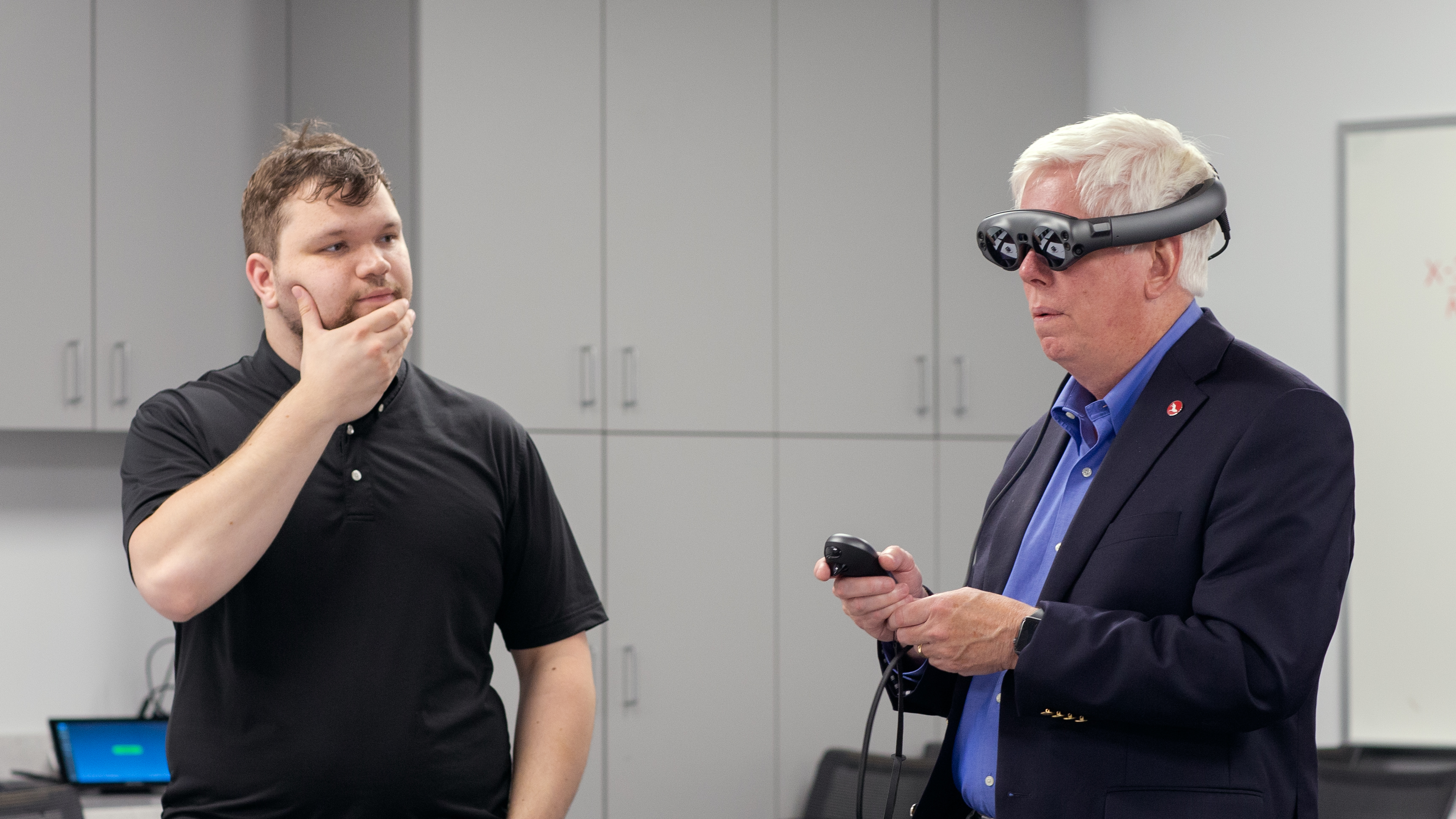“The New Reality.” You hear that phrase more and more often these days in the context of political climate, economic conditions, demographic shifts, etc. Usually the context is not positive, but in the context of ongoing and expanding work by DELTA and our faculty collaborators, this phrase is incredibly positive. The “new reality” I’m talking about is the use of technology-enabled approaches such as Virtual Reality (VR) and Augmented Reality (AR) applied in the context of teaching and learning. “What’s the big deal?” you may ask. VR and AR have been around for a good while now. True, but what’s significant is that there has recently been a “coming of age” of these technologies in terms of improved capabilities and lower costs that put them squarely in the “sweet spot” for engaging educational applications.

Immersive Media Developer Stephen Waddell (left) shows Vice Provost Tom Miller (right) the possibilities of spatial computing and XR in the classroom with Magic Leap.
My first truly impactful encounter with VR was a couple of years ago during a “demo day” organized by our New Media Development team, led by Creative Director Mike Cuales. Mike fitted me with a state-of-the-art VR headset and then transported me into a world that didn’t really exist, or did it? As far as all my human visual and auditory inputs and processing systems were concerned, it did exist! This was an experience not quite like any I’d ever had. It was actually exciting and discomforting at the same time. I was in a spaceship interacting with a levitated creature that looked like something out of Star Wars. The discomforting part was more subconscious than conscious. I’m sure it was driven by hard-wired synaptic pathways in my brain that had evolved over millions of years, telling me to be extremely wary of these strange things I was seeing all around me. My subconscious brain really could not tell the difference between this and reality, although my conscious mind was well aware of the difference. Once my conscious mind convinced my subconscious to calm down a bit, it was fun! I interacted with the creature (who was really very nice) and with my virtual environment. At one point I tried to put my space mouse down on the table beside me. I thought the table was real, but it wasn’t. That jolted me back to physical reality for just a second, and then my attention quickly returned to the virtual world around me. I was completely engaged.
I’m no stranger to cutting edge technology, and have spent time in immersive “caves” where a 360° world is projected all around you and other such things. Never, however, have I experienced anything like that high-end VR headset. The key thing, I think, is that it had my complete attention, both conscious and subconscious. Everyone knows Confucius’s quote “I hear and I forget, I see and I remember, I do and I understand.” I think if Confucius were alive today, he might reword that last phrase slightly to say, “I experience and I understand.”
Now, I don’t mean to say that experiencing a thing, a place, or an event through AR or VR is equivalent to doing, but when doing is not practical I believe that AR and VR, done well, can go a long way towards that holy grail of learning, which is understanding. The year before last, our team worked with the Global Training Initiative to create a series of VR training modules for developing cross-cultural competencies. Through VR, participants are immersed in a business meeting with people from different cultures and literally “get inside the head” of one of the participants. The impact of experiencing the meeting through the eyes and ears of someone from a different cultural background is pretty amazing. There is no way a classroom lecture could come close. That work has won multiple national awards and we’ve received numerous requests to apply the technology in other scenarios because it is so engaging.
DELTA supported seven academic courses this year in the exploration of mobile applications and virtual reality. For CH 222, we’ve created VR organic chemistry lab experiences which was recently highlighted on NPR’s Science Friday. We developed and implemented our first augmented reality products in education. For Feed Mill Management, we’re applying AR in FM 480 so students can view a pellet mill and mixer like never before. For a Graphic Design Theory course, AR is being used to enhance an existing textbook to increase student engagement with the content.
Have a look at DELTA’s Immersive Media Timeline to see just how far we’ve come with applying these technologies to NC State courses over the past few years, and learn more about the New Reality for Online Education that’s happening at NC State. I hope you enjoy these and other stories about the many exciting things that DELTA is helping our faculty bring to fruition in the classroom (real or virtual) through creative and effective application of technology. It is truly Think and Do applied.
Sincerely,
Dr. Tom Miller
Vice Provost, DELTA
Senior Vice Provost, Academic Outreach and Entrepreneurship
